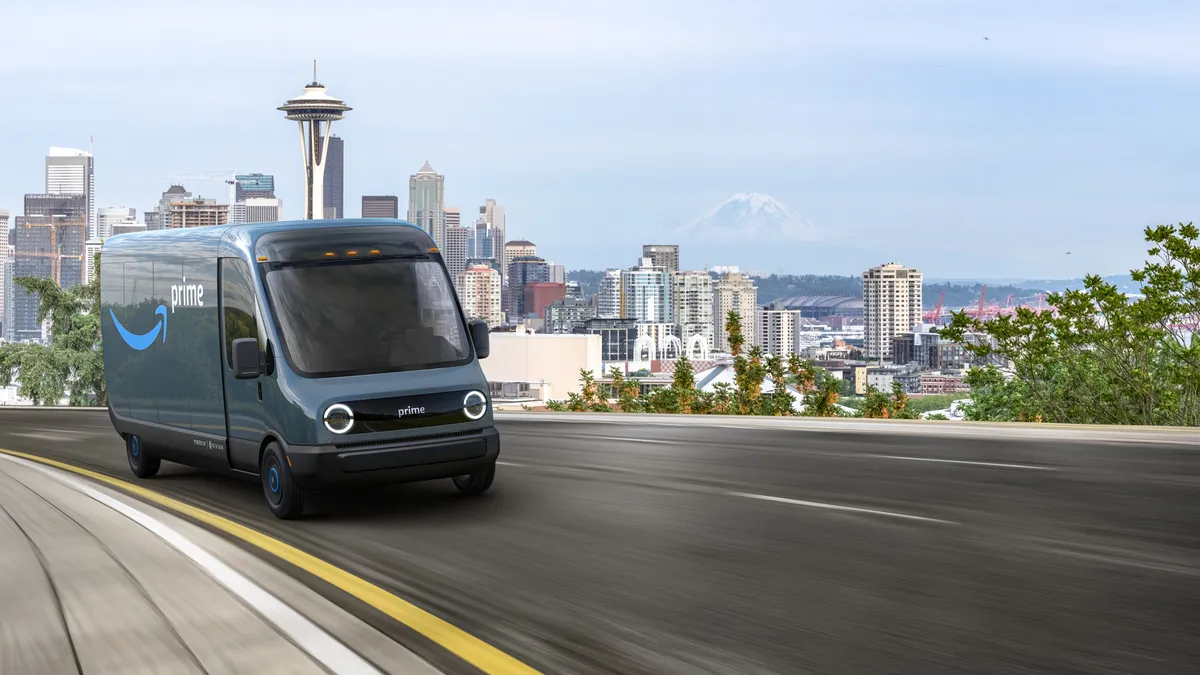Dive Brief:
- Amazon announced a series of sustainability goals Thursday, including a commitment to net zero carbon emissions by 2040, 10 years ahead of the goal date set by the Paris Climate Accord. Amazon also formed The Climate Pledge, to which it is the first signatory.
- The company said it would meet the goals through "efficiency improvements, renewable energy, materials reductions, and other carbon emission elimination strategies," according to a press release. Amazon said it would also neutralize remaining emissions with carbon offsets.
- Amazon placed an order for 100,000 electric delivery vans from manufacturer Rivian. The e-commerce company will begin deliveries to customers using the vans in 2021, and all 100,000 will be on the road by 2030. Amazon said the use of the electric vans will save 4 million metric tons of carbon annually by 2030.
Dive Insight:
"We want to use our scale and our scope to lead the way," Jeff Bezos, Amazon founder and CEO, said at an event announcing the sustainability goals and the Climate Pledge. And indeed Amazon's scale and scope are large. The company reported its total carbon footprint as 44.4 million metric tons in 2018.
The footprint is larger than many companies including UPS, FedEx, Apple, Alphabet and Target, according to CDP data cited by Bloomberg. But Amazon's footprint is still smaller than Walmart's.
Amazon's disclosure of sustainability goals has been long anticipated, at least since February when the company announced Shipment Zero, which includes the goal of 50% net zero carbon shipments by 2030. At the time, Dave Clark, SVP of worldwide operations, promised further details on steps to reach the Shipment Zero goal and information on the carbon footprint later in the year. The release of the goals comes just ahead of a planned walkout by more than 1,000 Amazon workers to protest the environmental impact of their employer.
Until now, Amazon has been relatively opaque about its sustainability initiatives, goals and carbon footprint. It hasn't published a sustainability report, putting it in the minority of Fortune 500 companies. Auburn University Professor Beth Davis-Sramek previously described Amazon's disclosure as "window dressing" compared to other companies, she told Supply Chain Dive. The simple act of disclosure may hold Amazon more accountable for reducing its emissions across operations and supply chain.
| Sustainability goal | Goal value and date |
|---|---|
| Net zero carbon | 100% by 2040 |
| Renewable energy | 80% by 2024; 100% by 2030 |
| Net zero carbon shipments | 50% by 2030 |
| Electric vehicles | 100,000 on the road by 2030 |
| Solar panels | 50 rooftops by 2020 (already met) |
Source: Amazon
Now that Amazon has outlined goals, many of them appear in line with, or even ambitious, compared to some of its competitors in the retail and logistics industries. Target has also set a goal for 100% renewable operations by 2030. However, UPS' goal is for sourcing just 25% of energy from renewables by 2025, and Walmart's is for 50% renewable energy use by 2025.
Amazon also claims its electric delivery van order is the largest order of electric delivery vehicles ever. The company was criticized last year when it ordered 20,000 vans for last-mile delivery but not a single electric one was electric, and Bezos acknowledged this on the call announcing the climate pledge. "We have a lot of delivery vans, and they all burn fossil fuels," he said.
In just over a decade, however, Amazon will have 100,000 electric vans on the road making last-mile deliveries. Currently, UPS has more than 10,000 "alternative fuel and advanced technology vehicles" in its fleet. FedEx has 2,554 electric vehicles in service.
Amazon's goals are ambitious. The question is if it will meet those goals, and how — whether through significant initiatives to reduce emissions and shrink packaging or mostly through offsets.
















